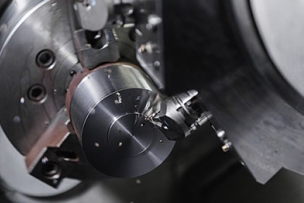Furthermore, this seemingly “overpriced commodity” is actually a bargain, assuming you and your team follow sound maintenance practices, that is.
“There’s a video on our website called ‘The Real Cost of Coolant’ explaining that cutting fluids represent just 0.5 percent of a shop’s total operating costs,” says John Treese, director of global training for Master Fluid Solutions. “It’s just an unbelievably small percentage.”
Keep Fluids Clean, Safe and Smelling Nice
Treese, who has a wealth of experience in maximizing cutting fluid life, notes that people tend to underestimate the role that coolant plays in all aspects of metalworking, with worker safety at the top of the list. “You just need one or two workers’ comp cases due to contact dermatitis or respiratory irritation and any money that you saved from a cheap coolant just went out the door—and then some,” he says. “Coolant affects so many things, and people forget that.”
Case in point: A Master Fluid Solutions customer who ran into financial troubles decided to change their cutting fluid to a lower-cost brand. Problems with tool life and part quality ensued, but the icing on the coolant cake occurred during a visit with a potential customer. “The place smelled so bad, the buyer wanted nothing to do with them and ended up finding a different shop to make their parts,” Treese says. “They’d learned their lesson at that point and put our coolant back in.”
Aside from lost sales opportunities and easily avoided workers’ compensation claims, shops must consider a host of other coolant-related costs if they’re to arrive at an accurate total cost of ownership (TCO) calculation:
- Direct Labor: The time spent by machine operators handling, mixing, maintaining and disposing of cutting fluids is often overlooked.
- Indirect Labor: The purchasing, procurement and receiving departments also play a role in cutting fluid management. It all takes time.
- Maintenance Operations: Preparing fluids for disposal and recycling, and sump cleanouts, especially, are time-consuming.
- Additive Expense: The cost for tank-side additives such as those used to control foam, bacteria and fungus as well as adjust pH levels might not seem like much, but they add up.
- Machine Downtime: Machines aren’t making parts when shut down for fluid changes, sump cleaning or maintenance related to cutting fluids.
- Component Replacement: Machine parts tend to wear more quickly or even break when the coolant system is in poor condition.
- Disposal Costs: Safely disposing of spent or contaminated cutting fluid, which is often considered hazardous waste, gets more expensive each year.
- Regulatory Compliance: Similarly, the costs associated with meeting environmental regulations are on the rise as more states and municipalities tighten the rules on fluid disposal.
- Reduced Tool Life: Worried about the next most expensive operating cost, cutting tools? Poorly managed or incorrect cutting fluid leads to premature tool wear, requiring more frequent tool replacements.
- Scrap and Rework: Using an ineffective cutting fluid can cause poor surface finish, dimensional inaccuracy, material waste, rework costs and—ultimately—scrapped parts.
- Lower Throughput: Poor fluid performance tends to limit machining speeds and feeds, reducing overall production rates.
Need Coolant Help? Here Are 19 Hacks to Avert Metalworking Fluid Foul-ups and Freakouts
Long story short, shops have far bigger fish to fry, and it’s high time they focused on optimizing their machining operations rather than chasing pennies. And as Treese will tell you, the real cost of coolant isn’t in what you spend on it; it’s in what happens when you ignore it.
With this in mind, there’s a great deal that facilities can do to minimize this expense; by following some common-sense steps, they can reduce their cutting fluid usage while also increasing productivity and therefore revenue far beyond the 0.5 percent figure mentioned earlier.
The Water Is the Problem (and the Solution)
Most coolants are mixed at 90 percent to 95 percent water. If that water is full of minerals, salts or contaminants, the coolant won’t perform correctly. “We always recommend against what is called ‘softened water,’” Treese says. “If the softening system doesn’t flush properly, you’re pumping saltwater into your machines … and saltwater has a tendency to rust machines and steel parts, and it’s harsh on coolant.”
Read On: A Guide to Machine Lubrication: Find the Right Water-Coolant Type
Instead, he recommends shops invest in a reverse osmosis (RO) or deionization (DI) system. These reduce hardness and allow the coolant to emulsify correctly, which extends tool life, improves cutting consistency and cuts chemical use. “Depending on the coolant you use, anywhere from about a quarter to 1 percent less chemical concentrate is needed for every grain of hardness you get rid of.”
Maintain Concentration—or Pay the Price
A common problem in shops is allowing coolant concentration to drop too low. Treese emphasizes that this leads to rapid bacterial growth, fluid degradation, rusting machine components and pH drift. “Fill your machine every day with the proper makeup concentration,” Treese advises. “If you’re running your machine at a reasonable rate … your sump is going to go down about 10 percent every day. You need to top it off with 2 percent or 3 percent concentration, depending on the material and how much heat or chip volume you’re generating.”
Don’t Dump in Chemicals (or Coffee)
When coolant starts to smell bad or lose effectiveness, some operators reach for household cleaners or pH adjusters. Treese is unambiguous: That’s a mistake. “We don’t recommend adding anything other than pH adjustments meant for the metalworking industry. Baking soda has lots of other stuff in there that can create issues. Similarly, pool chemicals are sometimes pretty nasty … you get those in your eyes, you can go blind.”
Equally important is to stop treating the sump like a trash can. “We joke about it, but I’ve seen people spit sunflower seeds or chewing tobacco in the sump or dump their warm soda or coffee into the machine. That only serves to feed the bacteria, and that leads to all kinds of problems, the infamous Monday Morning Stink among them.”
Recommended Reading: The Future of Metalworking Fluids, Machine Lubricants and Coolants
Final Takeaways
Minimize the use of biocides and other additives. Use a tramp oil skimmer. Routinely empty the chip pan, or better yet, install a chip conveyor. Invest in a sump sucker to speed and ease machine cleanouts. The list goes on. Fortunately, the Master Fluid Solutions website has a host of additional tips and other information, as does the MSC Knowledge Center.
Follow the guidance found in these resources and you can expect cutting fluids to last upward of two years, with greater, more predictable metal removal and tool life to boot.
“Coolant is a variable just like cutting tools, just like speeds and feeds,” Treese says. “If you do it right, you’re not just saving on fluid. You’re getting better part quality, longer tool life and less downtime. That’s the real cost of coolant—and the real value, too.”
Have you made changes to your coolant management routine that have had an impact on tool life or part quality? Tell us in the comments below.





Talk to Us!
Leave a reply
Your email address will not be published. Required fields are marked *